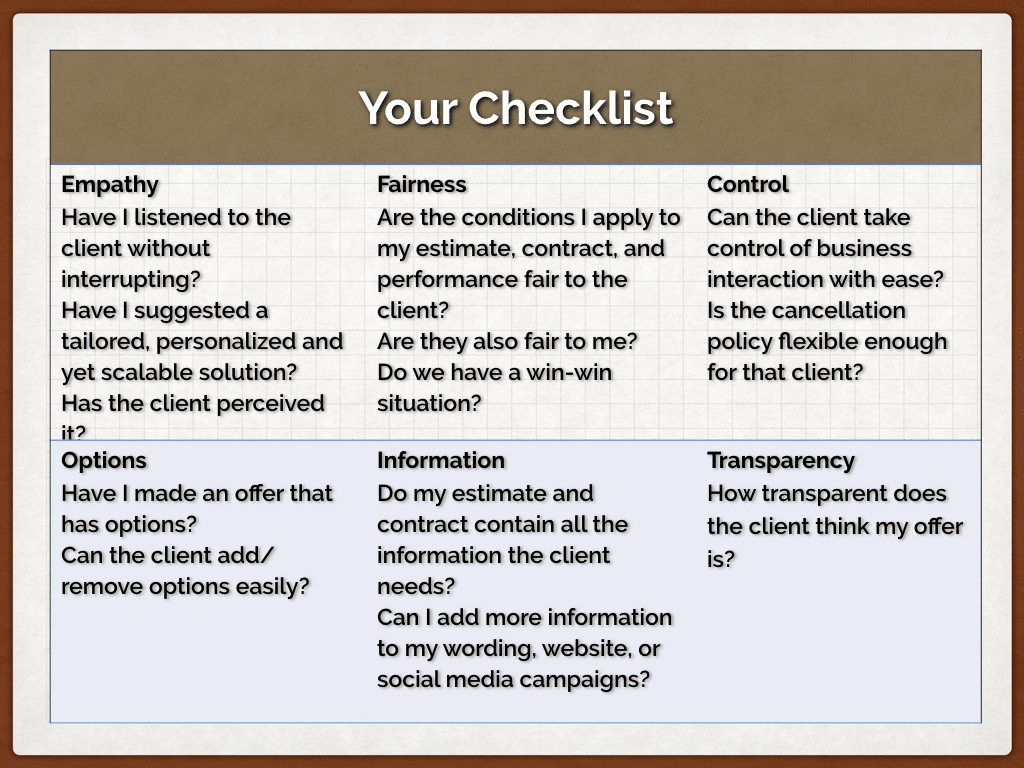My mother is a longtime fan of a soap opera called The Bold and the Beautiful, or B&B. Set in Los Angeles, California, this drama serial revolves around the Forrester family and their fashion house business, Forrester Creations.
Let alone the many intriguing twists in the screenplay, if there is something to learn from B&B is that crafting a new dress or collection requires going through a very complex process. While this is true for projects of any nature, the point I want to make is about understanding the client’s wants. That is key to writing a clear and yet concise estimate.
Creating a meaningful estimate, one that comprises all the elements you will (i.e. must) include in your contract, is like fitting a dress. You have to look at the client’s body type and fitting preference, suggest variations, or the accessories that would make his/her experience enjoyable and meet, or better exceed, expectations.
I have divided this post in two parts, before and after the estimate. In this first part I provide some advice on how to create an estimate. The second part will focus on guiding the client through your estimate. Let’s go.
Part 1 – Craft your estimate
It is not unusual to receive cold calls from agencies where the voice on the other side of the line asks the translator a quotation for translating 2,500 words from English into Spanish without context (oh, and they provide the maximum budget you must take, too). Giving an estimate off the cuff now may indeed prove to be a pain in the neck later. The same can be said about those “30-minute conferences” that you accept to do for $X only to discover that you should have charged twice that much. So, here’s what I suggest you to do:
Engage in active listening
Active listening is not an easy task. As the name suggests, it is about concentrating on what the speaker says rather than just passively hearing the message. The more you practice this, the more you become a good active listener and the easier you get the information you need. Nodding your head, smiling, maintaining eye contact, agreeing, and showing you are interested in them to continue are examples of positive attitude. Listening is not something that just happens (that is hearing). Listening is an active process in which people make the conscious decision to understand the messages of the speaker. Incidentally, this is also a good prerequisite for interpreting…just saying…
However, since active listening involves giving the other person time to explore his/her thoughts, we should also avoid jumping in with questions or comments every time there are a few seconds of silence. That happens because often we listen to respond (speaker says A; we reply B; next issue) and not to understand, i.e. get the big picture.
Active listeners have also another advantage: they can spot additional opportunities in what the speaker says, such as the possibility to give advice and guidance. This will further establish yourself as a go-to person in your prospects’ minds.
Don’t sell until you sell
If you want the prospect to run away from you before even saying to you what his/her needs are (reminder: you need those information for your offer) then go directly to business and lose the sale. Rather, try to just build a rapport, interact with prospects as persons, and make them talk.
Interrupting is a no go
As soon as you think you have figured out the solution, you can be tempted to interrupt and suggest your best solution while the client is still talking. Just don’t do it. That is the best way to ruin the conversation. It is their dreams, their goals, and their way to do things you are listening to. Just listen! Once you have a clear idea of the project – where the translated documents will be used and for what purpose, what the messages the speaker(s) want to convey are, and so on – you can concentrate on getting to the gist of the project.
Zero In
Let’s say what should not be included in your estimate. Your client is not interested in anything you don’t quote. So, if you have an item with a $0.00 price tag, just remove it from the estimate. Personalization gives the client the idea that the service will be fully tailored to his/her needs, which will help you close the sale. List services in the order they will be delivered, or you can group them. If you are providing translation, interpreting, and technical services list the translations first, then interpreting, and technical services last.
Some points to remember
Be clear!
Clear, competitive, and specific terms will always be preferred over vague terms. Therefore, make sure you indicate unit price, delivery time, and the scope of works in a way that is easy to read and understand.
There is no sale without payment!
Accounts payable and invoices are not cash. Only once you get the bank confirmation that the money is on your account your sale is final.
Always quote in writing!
Written quotes avoid confusion. Verbal quotes fine too, but they leave the door open to later interpretation and misunderstandings (e.g., “I thought you meant A, not B”).
Offer a professional estimate
Use your letterhead, thank the client for asking you to quote, organize the information, and – this is very important – check your spelling and punctuation.
Explain value
Explain your clients why your estimate is better than the others they will about how you can distinguish yourself by creating a unique selling proposition.
Meet your customer’s expectations and wants
Just be sure you’re very clear in what you suggest and make your client aware about what you’re offering.
Expect confirmation of arrangements
Include a checkbox in the estimate so that your client can accept your terms, sign, and deliver the confirmation to you.
Be flexible and adapt
Be prepared to accommodate changes if your client requests so, but also make clear that major shifts from the agreed conditions will likely cause a revision of fees.
Do not forget the basics
– Log the time you spend on tasks; these details will be useful in the future as you prepare the next estimate.
– Use previous estimates as a reference to prepare the current one.
– In delivering your services, consider the flat fees well, define the scope of your work, and allocate your time carefully.

Finally, a larger version of the table in the form of guidelines is available to download.
This is all for Part 1. In my next post, How to write an estimate and sell for translators and interpreters (Part II), I will write about the follow up phase, i.e., what to say to a client when you have sent the estimate.
BONUS HINT
If you want a quick solution to invoice or prepare an estimate online, you’d better check InvoiceSimple. With InvoiceSimple you can create an account, set your company’s information and logo, and create basic and yet effective estimates and invoices on the go.

